A Review of Distribution Grid Consumption Strategies Containing Distributed Photovoltaics
Abstract
:1. Introduction
2. Principle of Photovoltaic Power Generation and Consumption Mode
2.1. Principle of Photovoltaic Power Generation
2.2. Photovoltaic Power Generation Systems and Their Consumption Methods
2.2.1. Introduction to Photovoltaic Power Generation System
2.2.2. Consumption Methods for Distributed PV Access to Distribution Grids
3. Distribution Grid Consumption Strategy with Distributed PV
3.1. Study on the Strategy of Siting and Capacity Determination of Distribution Grids Containing Distributed PV
3.1.1. Objective Function
3.1.2. Constraints
3.1.3. Distributed PV Siting and Capacity Strategy
3.2. Optimization of Distribution Grid Energy Storage with Distributed Photovoltaics
3.2.1. Distributed PV Energy Storage Methods
3.2.2. Energy Storage Optimization for Distributed PV
- (1)
- Continued technological innovation: more efficient, low-cost, long-life energy storage technologies are expected to be introduced, such as solid-state batteries, metal-air batteries, and so on.
- (2)
- Further market expansion: with the further decline in the cost of energy storage and continued policy support, the market size of PV energy storage systems is expected to expand further.
- (3)
- Intelligent management enhancement: through integration with technologies such as Internet of Things, big data analysis and artificial intelligence, the management of PV energy storage systems will become more intelligent and improve energy utilization efficiency.
- (4)
- Distributed power generation and micro-grid development: PV energy storage will play an important role in the construction of distributed power generation and micro-grid, enhancing the stability and flexibility of the grid.
- (5)
- Significant environmental benefits: with the popularization of PV energy storage technology, it can reduce dependence on fossil fuels, help reduce greenhouse gas emissions, and promote environmental protection.
- (6)
- Convergence of electric vehicle charging network: the combination of PV energy storage systems and electric vehicle charging infrastructure will be one of the future development trends, realizing the complementarity of green transportation and energy.
3.3. Voltage Control Strategies for Distribution Grids Containing Distributed Photovoltaics
3.3.1. Voltage Control using PV Inverters
3.3.2. Voltage Coordination Control Methods
4. Conclusions
- The incorporation of distributed PV brings significant changes to the distribution grid, including shifts in energy generation patterns, increased complexity in grid operations, and challenges to traditional power system planning and operations management.
- Effective consumption strategies require comprehensive consideration of technical, economic, policy, and social factors. Optimizing the access mode of distributed PV, improving the regulation capability of the distribution grid, adopting advanced control strategies, formulating reasonable policies and incentive mechanisms, and strengthening technical research and development and personnel training are the keys to achieving effective consumption.
- Grid-connected power grids and energy storage systems are currently the main means of consumption. Grid connection can instantly consume a large amount of electricity, but it is necessary to solve the technical problems of grid access and the volatility of grid load. Energy storage systems can improve energy utilization but face cost, lifetime, and maintenance challenges.
- Future development trends indicate that, with advances in materials science and electronics technology, photovoltaic power generation technology will develop in the direction of high efficiency, low cost and long life. The development of smart grid and microgrid technologies will provide more possibilities for the consumption of PV power.
- In order to realize the sustainable development of distributed PV, it is necessary to adopt a comprehensive strategy of consumption and customized design in combination with region-specific environmental, economic, and social conditions. At the same time, the government, industry, and research organizations need to work together to promote policy formulation, technological innovation, and market mechanisms.
Author Contributions
Funding
Data Availability Statement
Conflicts of Interest
References
- Ye, X. Thinking about the development strategy of green power enterprises under the goal of “double carbon”. China Collect. Econ. 2023, 16, 25–28. [Google Scholar]
- Wang, J. Status and Prospect of Photovoltaic Power Generation Technology. Electron. Technol. 2023, 52, 307–309. [Google Scholar]
- Xu, T.; Wang, S.; Zhao, H. Joint optimization strategy of distribution network taking into account photovoltaic consumption and optical storage charging allocation. J. Electr. Eng. 2023, 1–10. [Google Scholar]
- Wang, K. Exploration of solar photovoltaic power generation microgrid technology. Low Carbon World 2018, 12, 72–73. [Google Scholar] [CrossRef]
- Huang, Z.Y. Research on Grid-Connected Design And Operation Analysis of Distributed Photovoltaic Power Generation. Master’s Thesis, Nanchang University, Nanchang, China, 2021. [Google Scholar] [CrossRef]
- Fu, Z.; Zhang, Z. A review of research on maximum power point tracking of photovoltaic cells. Power Technol. 2019, 43, 2067–2069+2073. [Google Scholar]
- Li, Y.Z. Design and Application of Solar Photovoltaic Grid-Connected Power Generation System; Mechanical Industry Press: South Norwalk, CT, USA, 2014. [Google Scholar]
- Han, S.; Wang, W.; Li, Z.; Fan, Z. Distributed photovoltaic siting and capacity determination method considering output uncertainty. Hebei Power Technol. 2023, 42, 24–29. [Google Scholar]
- Luo, W.; Peng, W.; Zheng, L. Optimized configuration and economic analysis of photovoltaic side battery energy storage system. Autom. Expo. 2023, 40, 66–69. [Google Scholar]
- Shao, F.; Xu, J.; Chen Bo Ye, G.; Tang, J.; Chen, F. Analysis of maximum allowable access peak capacity estimation of distributed photovoltaic power supply to smart grid. Integr. Circuit Appl. 2023, 40, 372–373. [Google Scholar] [CrossRef]
- Zhang, Z.; Wang, W. Application of distributed photovoltaic power generation system in microgrid. Light Source Light. 2022, 113–115. [Google Scholar]
- Chen, L.; Zhang, D.; Chen, J. Serving rural distributed PV grid-connected consumption. China Electricity News, 10 November 2021. [Google Scholar] [CrossRef]
- Li, Z. Study on the Impact of Distributed Photovoltaic Access on Distribution Network and Optimization of Siting and Capacity Setting. Master’s Thesis, Northeast Agricultural University, Harbin, China, 2021. [Google Scholar] [CrossRef]
- Cai, Y.L. Research on Distributed Power Source Siting and Capacity Determination Based on MTMBO Algorithm and Its Two-Phase Optimal Scheduling. Master’s Thesis, Nanchang University, Nanchang, China, 2021. [Google Scholar] [CrossRef]
- Wang, K. Research on The Evaluation Method of Photovoltaic Grid-Connected Siting and Capacity-Setting Scheme and Access Mode. Master’s Thesis, Wuhan University, Wuhan, China, 2018. [Google Scholar]
- Yan, H. Distributed power Siting and Capacity Determination for Distribution Grid Based on Immune Particle Swarm. Master’s Thesis, Northeast Agricultural University, Harbin, China, 2022. [Google Scholar] [CrossRef]
- Zhang, S. Research on the Grid-Connected Consumption Capacity of High Penetration Photovoltaic. Master’s Thesis, North China Electric Power University, Beijing, China, 2021. [Google Scholar] [CrossRef]
- Zhu, X.; Wang, B.; Li, H.; Liu, Y.; Gao, H.; Li, D. Study on distributed photovoltaic siting and capacitance of rural distribution network based on improved particle swarm algorithm. Power Capacit. React. Power Compens. 2020, 41, 206–214. [Google Scholar] [CrossRef]
- Zhu, X. Optimized Siting Analysis of Distributed Photovoltaic Access to Rural Distribution Grid. Master’s Thesis, Shandong University of Technology, Zibo, China, 2020. [Google Scholar] [CrossRef]
- Li, H. Research on Islanded Microgrid Siting and Capacity Determination based on Particle Swarm Algorithm. Master’s Thesis, Shandong University, Jinan, China, 2019. [Google Scholar]
- Hui, F. Research on Optimization Planning and Application of Distributed Photovoltaic Power Generation Cluster with High Penetration Rate. Master’s Thesis, Hefei University of Technology, Hefei, China, 2019. [Google Scholar]
- Cai, J. Distributed Power Siting and Capacity Determination Based on Improved Quantum Particle Swarm Algorithm. Master’s Thesis, Nanjing Normal University, Nanjing, China, 2018. [Google Scholar]
- Zhao, L. Research on Double-Layer Optimization Problem Based on Evolutionary Algorithm and Application. Master’s Thesis, Xi’an Electronic Science and Technology University, Xi’an, China, 2019. [Google Scholar] [CrossRef]
- Oudjana, S.H.; Zine, R.; Mosbah, M.; Khattara, A.; Arif, S. Optimal Placement of Distributed Generation Based PV Source in Electrical Power System for LVSI Improvement Using GA Algorithm. In Artificial Intelligence and Renewables Towards an Energy Transition; ICAIRES 2020, LNNS 174; Springer: Cham, Switzerland, 2021; pp. 252–259. [Google Scholar]
- Singh, A.; Sharma, A.; Rajput, S.; Bose, A.; Hu, X. An Investigation on Hybrid Particle Swarm Optimization Algorithms for Parameter Optimization of PV Cells. Electronics 2022, 11, 909. [Google Scholar] [CrossRef]
- Naresh Kumar, M.; Venkatesh Kumar, C.; Kamalakkannan, D.; Thopate, K.; Shanmugam, S.K.; Vignesh, T.; Kalpanadevi, D. An Optimized PV-Based Multi-Port Plug-In EV Charger Using Improved Particle Swarm Optimization Algorithm. Electr. Power Compon. Syst. 2023, 1–12. [Google Scholar] [CrossRef]
- Sikder, S.; Konar, G.; Chakraborty, N. Effect of Hybrid Energy Storage on Sizing of PV-Wind Standalone System using Bacteria Foraging Optimization Algorithm. In Proceedings of the 2018 20th National Power Systems Conference (NPSC) Tiruchirappalli, Tamilnadu, India, 14–16 December 2018. [Google Scholar]
- Zhang, C.; Zhang, M. Wavelet-based neural network with genetic algorithm optimization for generation prediction of PV plants. Energy Rep. 2022, 8, 10976–10990. [Google Scholar]
- Jayaudhaya, J.; Ramash Kumar, K.; Tamil Selvi, V.; Padmavathi, N. Improved Performance Analysis of PV Array Model Using Flower Pollination Algorithm and Gray Wolf Optimization Algorithm. Math. Probl. Eng. 2022, 2022, 1–17. [Google Scholar] [CrossRef]
- Ru, X. Parameter extraction of photovoltaic model based on butterfly optimization algorithm with chaos learning strategy. Sol. Energy 2024, 269, 112353. [Google Scholar] [CrossRef]
- Abd-Elazim, S.M.; Ali, E.S. Firefly algorithm-based load frequency controller design of a two area system composing of PV grid and thermal generator. Electr. Eng. 2017, 100, 1253–1262. [Google Scholar] [CrossRef]
- Nezhad, E.H.; Ebrahimi, R.; Ghanbari, M. Fuzzy Multi-objective Allocation of Photovoltaic Energy Resources in Unbalanced Network Using Improved Manta Ray Foraging Optimization Algorithm. Expert Syst. Appl. 2023, 234, 121048. [Google Scholar] [CrossRef]
- Dong, B.; Luzin, A.; Gura, D. The hybrid method based on ant colony optimization algorithm in multiple factor analysis of the environmental impact of solar cell technologies. Mathematical biosciences and engineering. Math. Biosci. Eng. 2020, 17, 6342–6354. [Google Scholar] [PubMed]
- Zhao, W.G.; Zhang, Z.X.; Wang, L.Y. Manta ray foraging optimization:An effective bio-inspired optimizer for engineering applications. Eng. Appl. Artif. Intell. 2020, 87, 1–25. [Google Scholar] [CrossRef]
- Tabone, M.D.; Goebel, C.; Callaway, D.S. The effect of PV siting on power system flexibility needs. Sol. Energy 2016, 139, 776–786. [Google Scholar] [CrossRef]
- Hashemi Toghroljerdi, S.; Østergaard, J.; Degner, T.; Brandl, R.; Heckmann, W. Efficient Control of Active Transformers for Increasing the PV Hosting Capacity of LV Grids. IEEE Trans. Ind. Inform. 2016, 13, 270–277. [Google Scholar] [CrossRef]
- Schmid, F.; Behrendt, F. Optimal sizing of Solar Home Systems: Charge controller technology and its influence on system design. Sustain. Energy Technol. Assess. 2021, 45, 101198. [Google Scholar] [CrossRef]
- Allouhi, A.; Amine, M.B.; Reisch, C. Multi-objective optimization of solar energy systems for electricity and hot water generation in collective residential buildings considering the power-to-heat concept. Appl. Therm. Eng. 2023, 230, 120658. [Google Scholar] [CrossRef]
- Bredemeier, D.; Schinke, C.; Niepelt, R.; Brendel, R. Large-scale spatiotemporal calculation of photovoltaic capacity factors using ray tracing: A case study in urban environments. Prog. Photovolt. Res. Appl. 2024, 32, 232–243. [Google Scholar] [CrossRef]
- Majeed, A.A.; Abderrahim, M.; Alkhazraji, A.A. Optimal Allocation of Photovoltaic-Green Distributed Generation for Maximizing the Performance of Electrical Distribution Networks. Energies 2024, 17, 1376. [Google Scholar] [CrossRef]
- Hraiz, M.D.; García JA, M.; Castañeda, R.J.; Muhsen, H. Optimal PV Size and Location to Reduce Active Power Losses While Achieving Very High Penetration Level With Improvement in Voltage Profile Using Modified Jaya Algorithm. IEEE J. Photovolt. 2020, 10, 1166–1174. [Google Scholar] [CrossRef]
- Serrano-Luján, L.; Espinosa, N.; Abad, J.; Urbina, A. The greenest decision on photovoltaic system allocation. Renew. Energy 2016, 101, 1348–1356. [Google Scholar] [CrossRef]
- Martín-Jiménez, J.; Del Pozo, S.; Sánchez-Aparicio, M.; Lagüela, S. Multi-scale roof characterization from LiDAR data and aerial orthoimagery:Automatic computation of building photovoltaic capacity. Autom. Constr. 2020, 109, 102965. [Google Scholar] [CrossRef]
- Castillo-Calzadilla, T.; Macarulla, A.M.; Borges, C.E. Design of Sizing Algorithms for a Direct Current Off-Grid Photovoltaic Installation. IEEE Lat. Am. Trans. 2018, 16, 2168–2176. [Google Scholar] [CrossRef]
- Żołądek, M.; Sornek, K.; Papis, K.; Figaj, R.; Filipowicz, M. Experimental and numerical analysis of photovoltaics system improvements in urban area. Civ. Environ. Eng. Rep. 2018, 28, 13–24. [Google Scholar] [CrossRef]
- Chwieduk, D.; Bujalski, W.; Chwieduk, B. Possibilities of Transition from Centralized Energy Systems to Distributed Energy Sources in Large Polish Cities. Energies 2020, 13, 6007. [Google Scholar] [CrossRef]
- Bartecka, M.; Barchi, G.; Paska, J. Time-Series PV Hosting Capacity Assessment with Storage Deployment. Energies 2020, 13, 2524. [Google Scholar] [CrossRef]
- Brinkel, N.; Gerritsma, M.; Al Skaif, T.; Lampropoulos, I.; van Voorden, A.; Fidder, H.; van Sark, W. Impact of rapid PV fluctuations on power quality in the low-voltage grid and mitigation strategies using electric vehicles. Electr. Power Energy Syst. 2020, 118, 105741. [Google Scholar] [CrossRef]
- González, R.M.; Torbaghan, S.S.; Gibescu, M.; Cobben, S. Harnessing the Flexibility of Thermostatic Loads in Microgrids with Solar Power Generation. Energies 2016, 9, 547. [Google Scholar] [CrossRef]
- Kisuule, M.; Ndawula, M.B.; Gu, C.; Hernando-Gil, I. PV Hosting Capacity in LV Networks by Combining Customer Voltage Sensitivity and Reliability Analysis. Energies 2023, 16, 5893. [Google Scholar] [CrossRef]
- Kougias, I.; Bódis, K.; Jäger-Waldau, A.; Moner-Girona, M.; Monforti-Ferrario, F.; Ossenbrink, H.; Szabó, S. The potential of water infrastructure to accommodate solar PV systems in Mediterranean islands. Sol. Energy 2016, 136, 174–182. [Google Scholar] [CrossRef]
- Nassen, J.; Evertsson, J.; Andersson, B.A. Distributed Power Generation versus Grid Extension: An Assessment of Solar Photovoltaics for Rural Electrification in Northern Ghana. Prog. Photovolt. Res. Appl. 2002, 10, 495–510. [Google Scholar] [CrossRef]
- Zeng, T.-W.; Wei, C.; Liu, D. An Energy Storage Control Device Based on Solar Photovoltaic Power Generation Control. CN Patent CN202122727251.8, 28 May 2024. [Google Scholar]
- Schulte, J.; Figgener, J.; Woerner, P.; Broering, H.; Sauer, D.U. Forecast-based charging strategy to prolong the lifetime of lithium-ion batteries in standalone PV battery systems in Sub-Saharan Africa. Sol. Energy 2023, 258, 130–142. [Google Scholar] [CrossRef]
- Zhang, S.; Miao, S.; Li, Y.; Yin, B.; Li, C. Regional integrated energy system dispatch strategy considering advanced adiabatic compressed air energy storage device. Int. J. Electr. Power Energy Syst. 2021, 125, 106519. [Google Scholar] [CrossRef]
- Raut, K.; Shendge, A.; Chaudhari, J.; Lamba, R.; Alshammari, N.F. Modeling and simulation of photovoltaic powered battery-supercapacitor hybrid energy storage system for electric vehicles. J. Energy Storage 2024, 82, 110324. [Google Scholar] [CrossRef]
- Liu, Y.; Wang, Y.; Bai, X.; Li, X.; Ning, Y.; Song, Y.; Li, X.; Mu, D. Review on modeling and control of megawatt liquid flow energy storage system. Energy Rep. 2023, 9, 113–123. [Google Scholar] [CrossRef]
- Mohammed, A.; Ghaithan, A.M.; Al-Hanbali, A.; Attia, A.M. A multi-objective optimization model based on mixed integer linear programming for sizing a hybrid PV-hydrogen storage system. Int. J. Hydrogen Energy 2023, 48, 9748–9761. [Google Scholar] [CrossRef]
- Zeidan, M.; Al-soud, M.; Dmour, M.; Alakayleh, Z.; Al-Qawabah, S. Integrating a Solar PV System with Pumped Hydroelectric Storage at the Mutah University of Jordan. Energies 2023, 16, 5769. [Google Scholar] [CrossRef]
- Mishra, A.K.; Singh, B.; Kim, T. An Efficient and Credible Grid-Interfaced Solar PV Water Pumping System with Energy Storage. IEEE J. Photovolt. 2022, 12, 880–887. [Google Scholar] [CrossRef]
- Fu, L. Analysis of a new photovoltaic lithium-ion unbalanced management energy storage and power generation system. China Met. Bull. 2020, 6, 252–253. [Google Scholar]
- Xu, G.; Lei, L.; Hou, J.; Liang, L.; Song, J. Virtual inertia coordinated control strategy for optical storage system with compressed air energy storage. J. North China Electr. Power Univ. (Nat. Sci. Ed.) 2020, 47, 103–110. [Google Scholar]
- Liu, F. Distributed Photovoltaic Power Generation System Based on Supercapacitor Hybrid Energy Storage. Master’s Thesis, Anhui University of Technology, Hefei, China, 2022. [Google Scholar] [CrossRef]
- Guo, X.; Yu, H.; Zheng, X.; Li, Y.; Zuo, Y.; Zhang, M. Optimized configuration of liquid flow battery energy storage for photovoltaic systems. Energy Storage Sci. Technol. 2023, 12, 1158–1167. [Google Scholar] [CrossRef]
- Ji, B.-Y. Control Strategy and Optimal Configuration of High Penetration Photovoltaic Distribution Network Based on Hydrogen Energy Storage. Bachelor’s Thesis, Yanshan University, Qinhuangdao, China, 2022. [Google Scholar] [CrossRef]
- Liu, X.; Ning, X.F.; Jin, Y.; Yang, C.; Zhang, W.; Zhu, Y. Hierarchical optimal allocation method for distributed energy storage in distribution networks. Zhejiang Electr. Power 2023, 42, 95–104. [Google Scholar] [CrossRef]
- Tian, X.; Chen, L.; Li, X. Optimal operation strategy of distributed photovoltaic community shared energy storage based on master-slave game and improved Shapley value. Grid Technol. 2023, 47, 2252–2261. [Google Scholar] [CrossRef]
- Wang, C.; Sun, J.; Xu, Q.; Ge, J. Optimized scheduling of integrated energy system for high percentage photovoltaic area based on CVaR. Eng. Sci. Technol. 2023, 55, 97–106. [Google Scholar] [CrossRef]
- Peng, W.; Zheng, L.Q.; Zheng, T.M. Optimal allocation method of distributed photovoltaic energy storage system. Sichuan Power Technol. 2022, 45, 45–49+94. [Google Scholar] [CrossRef]
- Wei, L.; Zhao, B.; Wu, H.; Zhang, X. Optimal allocation of distributed photovoltaic and energy storage systems based on improved particle swarm algorithm. Integr. Intell. Energy 2023, 45, 49–57. [Google Scholar]
- Wang, X.; Chen, Z.; Bian, Z. Optimal allocation of wind and storage capacity for smart microgrid based on particle swarm optimization algorithm. Integr. Smart Energy 2022, 44, 52–58. [Google Scholar]
- Li, C.; Wang, X.; Wei, S.; Yang, S. Optimal allocation of energy storage capacity considering wind-scenery probability distribution based on improved firefly algorithm. Electr. Autom. 2022, 44, 7–10. [Google Scholar]
- Chandola, R.; Panchal, A.K. A standalone photovoltaic energy storage application with positive pulse current battery charging. J. Energy Storage 2024, 85, 111184. [Google Scholar] [CrossRef]
- Gugulothu, R.; Nagu, B.; Pullaguram, D.; Babu, B.C. Optimal coordinated energy management strategy for standalone solar photovoltaic system with hybrid energy storage. J. Energy Storage 2023, 67, 107628. [Google Scholar] [CrossRef]
- Mathivanan, V.; Ramabadran, R.; Nagappan, B.; Devarajan, Y. Assessment of photovoltaic powered flywheel energy storage system for power generation and conditioning. Sol. Energy 2023, 264, 112045. [Google Scholar] [CrossRef]
- Sharma, P.K.; Kumar, D.A.; William, P.; Obulesu, D.; Pandian, P.M.; Khan, T.K.; Manikandan, G. Energy storage system based on hybrid wind and photovoltaic technologies. Meas. Sens. 2023, 30, 100915. [Google Scholar] [CrossRef]
- Maka, A.O.M.; Chaudhary, T.N. Performance investigation of solar photovoltaic systems integrated with battery energy storage. J. Energy Storage 2024, 84, 110784. [Google Scholar] [CrossRef]
- Akinte, O.O.; Plangklang, B.; Prasartkaew, B.; Aina, T.S. Energy Storage Management of a Solar Photovoltaic–Biomass Hybrid Power System. Energies 2023, 16, 5122. [Google Scholar] [CrossRef]
- Modu, B.; Abdullah, M.P.; Bukar, A.L.; Hamza, M.F.; Adewolu, M.S. Energy management and capacity planning of photovoltaic-wind-biomass energy system considering hydrogen-battery storage. J. Energy Storage 2023, 73, 109294. [Google Scholar] [CrossRef]
- Hettiarachchi, D.; Rajakaruna, S.; Ghosh, A. Development of control strategy for community battery energy storage system in grid-connected microgrid of high photovoltaic penetration level. Electr. Power Energy Syst. 2024, 155, 109527. [Google Scholar] [CrossRef]
- Soares, L.T.F.; de Souza, A.C.; Silva, W.W.A.G.; Pugliese, L.F.; Alves, G.H. Grid-Connected Photovoltaic Systems with Energy Storage for Ancillary Services. Energies 2023, 16, 7379. [Google Scholar] [CrossRef]
- Kermani, A.; Jamshidi, A.M.; Mahdavi, Z.; Dashtaki, A.A.; Zand, M.; Nasab, M.A.; Samavat, T.; Sanjeevikumar, P.; Khan, B. Energy Management System for Smart Grid in the Presence of Energy Storage and Photovoltaic Systems. Int. J. Photoenergy 2023, 2023, 5749756. [Google Scholar] [CrossRef]
- Wu, Q.; Wang, F.; Zhou, T.; Guo, L. Impact of distributed photovoltaic power quality problems and management methods. Electrotechnology 2023, 2, 167–170+174. [Google Scholar] [CrossRef]
- Gu, T.Y.; Sun, S.L.; Tian, Y.; Wang, Z.; Li, H. A review of reactive voltage control methods for high-ratio distributed photovoltaic grid-connected systems. Northeast. Electr. Power Technol. 2023, 44, 1–5+36. [Google Scholar]
- Wu, B.; Jin, G.; Feng, Z.; Hua, H. Photovoltaic inverter participation in grid reactive voltage control strategy. Power Energy 2022, 43, 429–433. [Google Scholar]
- Wang, H.; Huang, X.; Li, H.; Peng, Y.; Ren, T.; Li, Q. Voltage coordinated control method for three-phase traction power supply system with distributed photovoltaic access. High Volt. Technol. 2024, 50, 1645–1654. [Google Scholar] [CrossRef]
- Yang, J.; Wang, W.; Zhang, M.; Wang, L.; Zhang, Q.; Li, C.; Zhou, Z. A voltage hierarchical control method for distribution networks considering distributed photovoltaic and energy storage participation. J. Power Sci. Technol. 2023, 38, 111–120+215. [Google Scholar]
- Yang, Y.; Zhang, L.; Xie, S. A photovoltaic MPPT method based on improved viscous bacteria optimization algorithm. Autom. Instrum. 2023, 38, 1–5. [Google Scholar] [CrossRef]
- Wei, Y.Q.; Li, Z.; Lin, M.H.; Yue, Z. Application study of dual optimized PSO in photovoltaic MPPT under partial shading. Power Supply Technol. 2023, 47, 260–264. [Google Scholar]
- Sun, Y.; Zhang, J.; Zhou, Q.; Li, C. Research on photovoltaic MPPT control based on improved flower pollination algorithm. Power Technol. 2023, 47, 528–532. [Google Scholar]
- Ma, Z.; Zhang, J. Research on photovoltaic MPPT based on improved flower pollination algorithm. Power Technol. 2023, 47, 795–799. [Google Scholar]
- Mao, M.; Xu, Z.; Cui, L.; Zhu, L.; Guo, K.; Zhou, L. Research on multi-peak MPPT of photovoltaic array based on improved gray wolf optimization algorithm. J. Sol. Energy 2023, 44, 450–456. [Google Scholar] [CrossRef]
- Li, D.; Zhou, H.; Zhou, Y.; Rao, Y.; Yao, W. MPPT design of hybrid photovoltaic-temperature differential system based on multivariate universe optimization algorithm. China Power 2023, 56, 197–205. [Google Scholar]
- Wang, Y.; Dai, Y. MPPT control of photovoltaic system based on expert demonstration deep reinforcement learning. Power Supply Technol. 2023, 47, 265–270. [Google Scholar]
- Yu, L.; Xie, X. MPPT control of photovoltaic power generation system based on AC reinforcement learning. J. Power Supply, 2023; in print. [Google Scholar]
- Wang, Z.-B. Maximum power point tracking based on constant voltage method combined with variable step-size conductance increment method. Sci. Technol. Eng. 2012, 12, 4638–4642. [Google Scholar]
- Ali, M.N.; Mahmoud, K.; Lehtonen, M.; Darwish, M.M.F. An Efficient Fuzzy-Logic Based Variable-Step Incremental Conductance MPPT Method for Grid-Connected PV Systems. IEEE Access 2021, 9, 26420–26430. [Google Scholar] [CrossRef]
- Chai, Y.-B.; Pu, X.I. Variable step-size incremental conductance method used in PV power system. IOP Conf. Ser. Earth Environ. Sci. 2019, 295, 042006. [Google Scholar] [CrossRef]
- Gil-Velasco, A.; Aguilar-Castillo, C. A Modification of the Perturb and Observe Method to Improve the Energy Harvesting of PV Systems under Partial Shading Conditions. Energies 2021, 14, 2521. [Google Scholar] [CrossRef]
- Sun, Y.; Sun, X.; Zhang, Y.; Wu, Y.; Dai, B. Research on MPPT of PV System Based on IPSO Algorithm. Proc. SPIE—Int. Soc. Opt. Eng. 2022, 12288, 443–450. [Google Scholar]
- Yi, L.; Ma, H.; Wang, Y.; Liu, J.; Shi, H.; Cheng, S. An Improved Hunger Games Search Algorithm-based Multi-peak MPPT Control for PV System under Partial Shading. Recent Patents Mech. Eng. 2023, 16, 261–273. [Google Scholar] [CrossRef]
- Zhao, Y.; An, A.; Xu, Y.; Wang, Q.; Wang, M. Model predictive control of grid-connected PV power generation system considering optimal MPPT control of PV modules. Prot. Control Mod. Power Syst. 2021, 6, 32. [Google Scholar] [CrossRef]
- Gao, W.; Jin, H.; Yang, G. Series arc fault diagnosis method of photovoltaic arrays based on GASF and improved DCGAN. Adv. Eng. Inform. 2022, 54, 101809. [Google Scholar] [CrossRef]
- Hai, T.; Zhou, J.; Furukawa, N. Performance enhancement of fuzzy-PID controller for MPPT of PV system to extract maximum power under different conditions. Soft Comput. 2024, 28, 2035–2054. [Google Scholar] [CrossRef]
- Ge, Q.; Li, Z.; Qiu, B.; Xu, J.; Xu, X. MPPT composite algorithm for photovoltaic modules under localized shading. J. Jiangsu Univ. (Nat. Sci. Ed.) 2023, 44, 547–553. [Google Scholar]
- Yu, K.; Tang, X.; Chen, X.; Bu, L.; Hua, H.; Ding, Y.; Shen, J. Overvoltage responsibility sharing method for distribution network with high percentage of distributed photovoltaic access. Chin. J. Electr. Eng. 2023, 43, 9535–9546. [Google Scholar]
- Shi, Q.; Wan, H.; Liu, W.; Han, H.; Wang, Z.; Li, F. Voltage control strategy for inter-cluster cooperative distributed energy storage under high photovoltaic penetration. Power Syst. Autom. 2023, 47, 47–56. [Google Scholar]
- Sun, Y.; Zhao, S.; Zhang, X.; Hang, Y.; Zhang, H. Voltage stability control method for regional power grid considering distributed photovoltaic and energy storage combination. Renew. Energy 2022, 40, 1115–1122. [Google Scholar] [CrossRef]
- Jiang, T.; Zhang, D.F.; Li, X.; Li, R.; Li, G. Distributed optimal control of active distribution network voltage containing distributed photovoltaic. Power Autom. Equip. 2021, 41, 102–109+125. [Google Scholar] [CrossRef]
- Ma, Q.; Hao, Z.; Zhang, Y.; Yang, S.; Chen, Z.; Luo, Q. Network partitioning and voltage coordinated control of distributed photovoltaic distribution networks with high penetration. Grid Clean Energy 2023, 39, 93–102+108. [Google Scholar]
- Chen, B.; Jia, Y.; Wang, S.; Liu, L.; Zhou, X.; Zhu, X. A decentralized voltage control method for photovoltaic clusters considering communication deficit scenarios. Power Autom. Equip. 2023, 43, 152–158+167. [Google Scholar] [CrossRef]
- Kumar, M.; Sen, S.; Kumar, S.; Samantaray, J. An Adaptive Fuzzy Controller-Based Distributed Voltage Control Strategy for a Remote Microgrid System with Solar Energy and Battery Support. IEEE Trans. Ind. Appl. 2024, 60, 4870–4887. [Google Scholar] [CrossRef]
- Haghighat, M.; Niroomand, M.; Tafti, H.D. An Adaptive Power Ramp Rate Control Method for Photovoltaic Systems. IEEE J. Photovolt. 2021, 12, 557–564. [Google Scholar] [CrossRef]
- Daravath, R.; Sandepudi, S.R. Low voltage ride through control strategy for grid-tied solar photovoltaic inverter. Int. J. Emerg. Electr. Power Syst. 2024, 25, 249–268. [Google Scholar] [CrossRef]
- Rehman, N.; Mufti, M.-U.D.; Gupta, N. Adaptive Dynamic Droop Control for Photovoltaic-Rich Distribution Networks Considering Photovoltaic Uncertainties. Energy Sources Part A Recovery Util. Environ. Eff. 2023, 45, 8642–8664. [Google Scholar] [CrossRef]
- Waghmare, T.; Chaturvedi, P. A higher-order sliding mode controller’s super twisting technique for a DC–DC converter in photovoltaic applications. Energy Rep. 2023, 9, 581–589. [Google Scholar] [CrossRef]
- Abadi, S.A.G.K.; Khalili, T.; Habibi, S.I.; Bidram, A.; Guerrero, J.M. Adaptive control and management of multiple nano-grids in an islanded dc microgrid system. IET Gener. Transm. Distrib. 2023, 17, 1799–1815. [Google Scholar] [CrossRef]
- Vosoughi Kurdkandi, N.; Marangalu, M.G.; Alavi, P.; Gharehkoushan, A.Z.; Rahimpour, S.; Islam, M.R.; Muttaqi, K.M. A new transformer-less common grounded five-level grid-tied inverter with leakage current elimination and voltage boosting capability for photovoltaic applications. IET Renew. Power Gener. 2023, 17, 1557–1582. [Google Scholar] [CrossRef]
- Jamshidpour, E.; Jovanovic, S.; Poure, P. Equivalent Two Switches and Single Switch Buck/Buck-Boost Circuits for Solar Energy Harvesting Systems. Energies 2020, 13, 583. [Google Scholar] [CrossRef]
- Moury, S.; Lam, J. A Soft-Switched, Multiport Photovoltaic Power Optimizer With Integrated Storage Interface and Output Voltage Regulation. IEEE Trans. Ind. Electron. 2020, 68, 3917–3927. [Google Scholar] [CrossRef]
- Eid, B.M.; Guerrero, J.M.; Abusorrah, A.M.; Islam, M.R. A new voltage regulation strategy using developed power sharing techniques for solar photovoltaic generation-based microgrids. Electr. Eng. 2021, 103, 3023–3031. [Google Scholar] [CrossRef]
- Jamshidi, F.; Salehizadeh, M.R.; Yazdani, R.; Azzopardi, B.; Jately, V. An Improved Sliding Mode Controller for MPP Tracking of Photovoltaics. Energies 2023, 16, 2473. [Google Scholar] [CrossRef]
- Chanhome, A.; Chaitusaney, S. Coordination between the central control unit and local control function of a photovoltaic system under the uncertainties of sunlight and three-phase unbalanced loads. IET Renew. Power Gener. 2021, 15, 2168–2184. [Google Scholar] [CrossRef]
- Yang, L.; Ren, X.; Cai, Z.; Qi, Q.; Li, Z.; Xia, X.; Nian, H. A review of voltage control strategies for distribution networks with high photovoltaic penetration. Grid Technol. 2024; in press. [Google Scholar] [CrossRef]
- Cai, Y.X.; Tang, W.; Zhang, L.; Xu, O. Multi-mode voltage control in low distribution networks based on reactive power regulation of photovoltaic inverters. Autom. Electr. Power Syst. 2017, 41, 133–141. [Google Scholar]
- Lui, J.Y.; Li, Y.; Cao, Y.J.; Shi, J. Suppression method of voltage rise in medium and low distribution networks considering utilization efficiency of photovoltaic power. Autom. Electr. Power Syst. 2018, 42, 171–177. [Google Scholar]
- Guo, Q.Y.; Wu, J.K.; Mo, C.; Xu, H. A model for multi-objective coordination optimization of voltage and reactive power in distribution networks based on mixed integer second-order cone programming. Proc. CSEE 2018, 38, 1385–1396. [Google Scholar]
- Pereira, L.D.; Yahyaoui, I.; Fiorotti, R.; de Menezes, L.S.; Fardin, J.F.; Rocha, H.R.; Tadeo, F. Optimal allocation of distributed generation and capacitor banks using probabilistic generation models with correlations. Appl. Energy 2022, 307, 118097. [Google Scholar] [CrossRef]
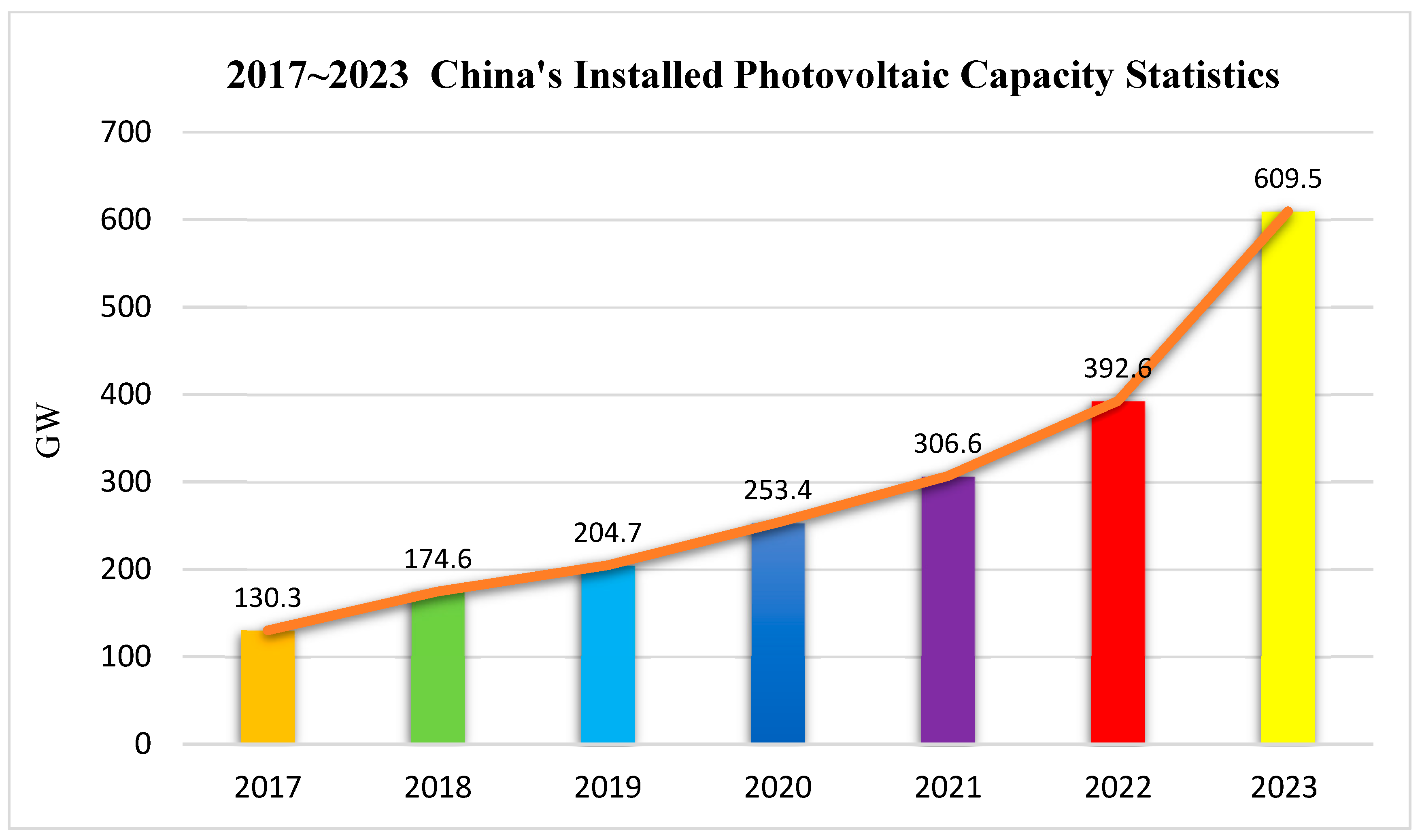


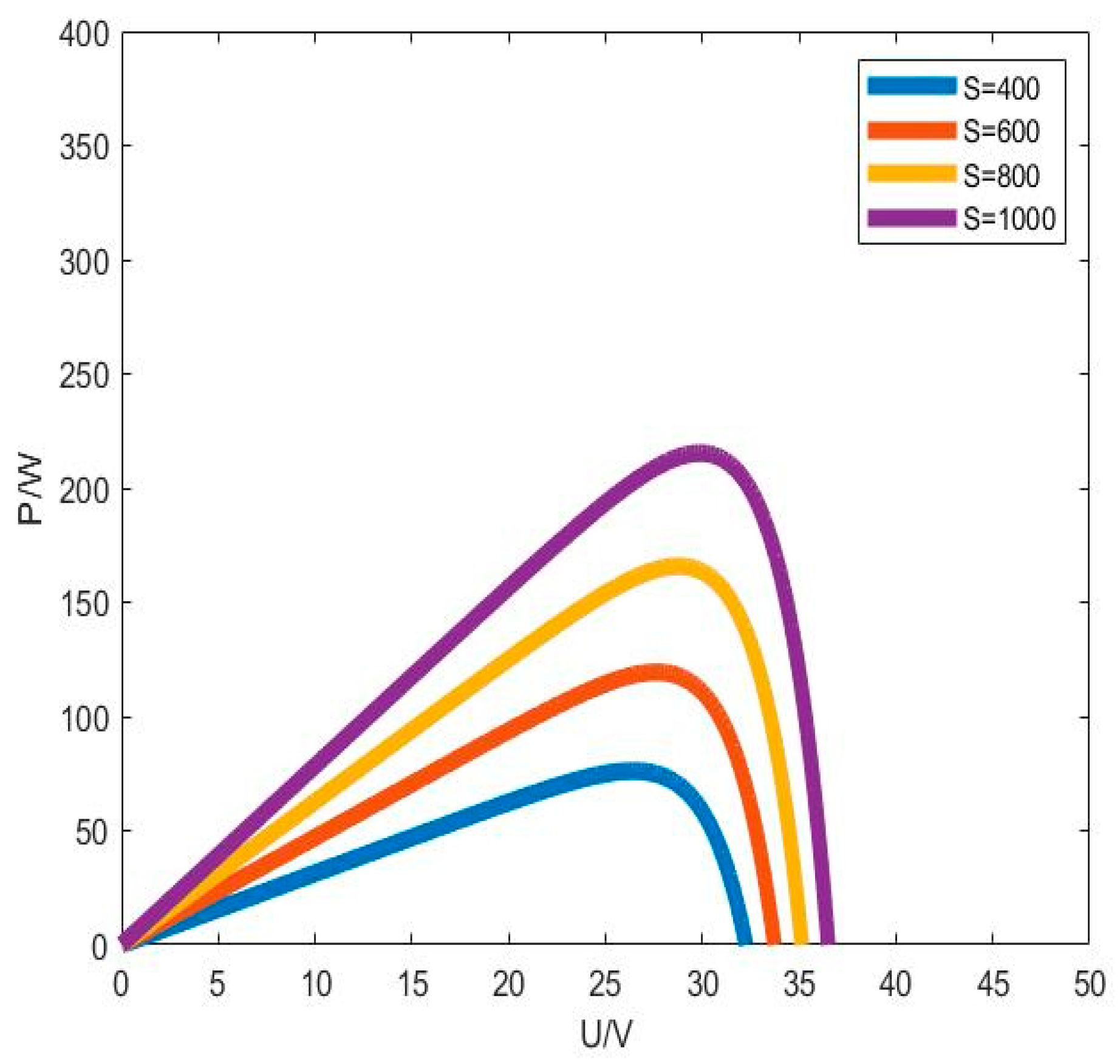
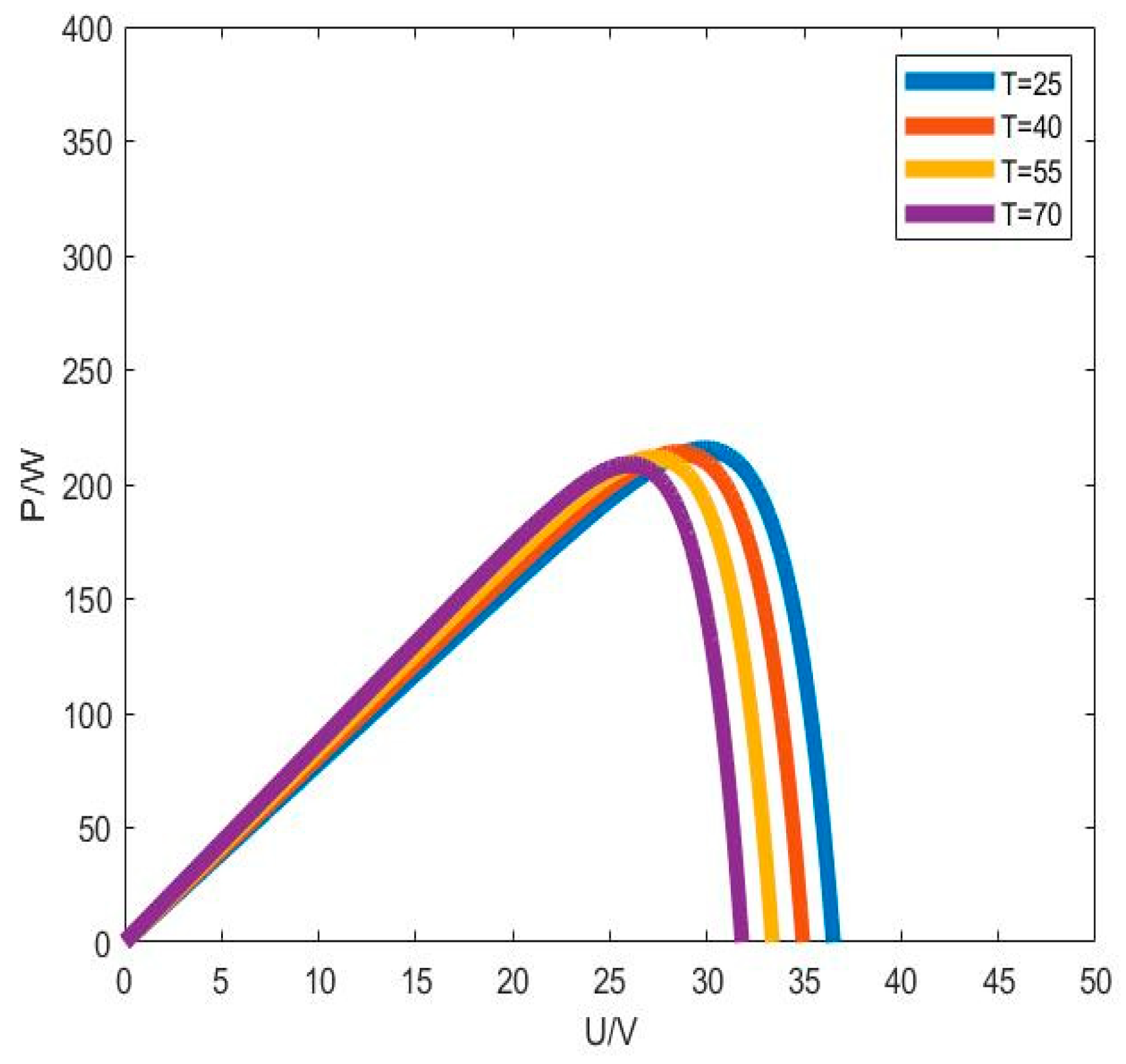

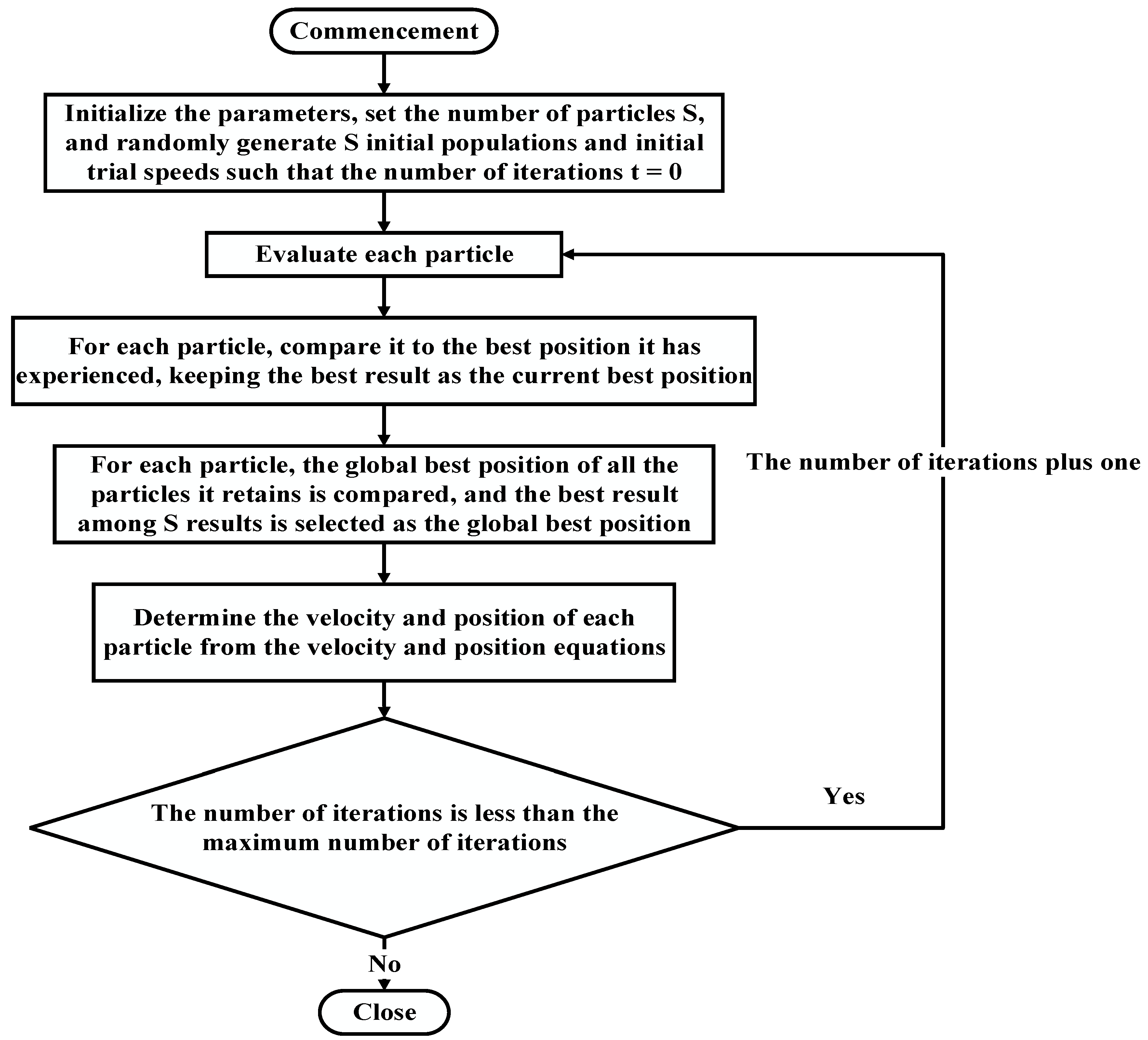

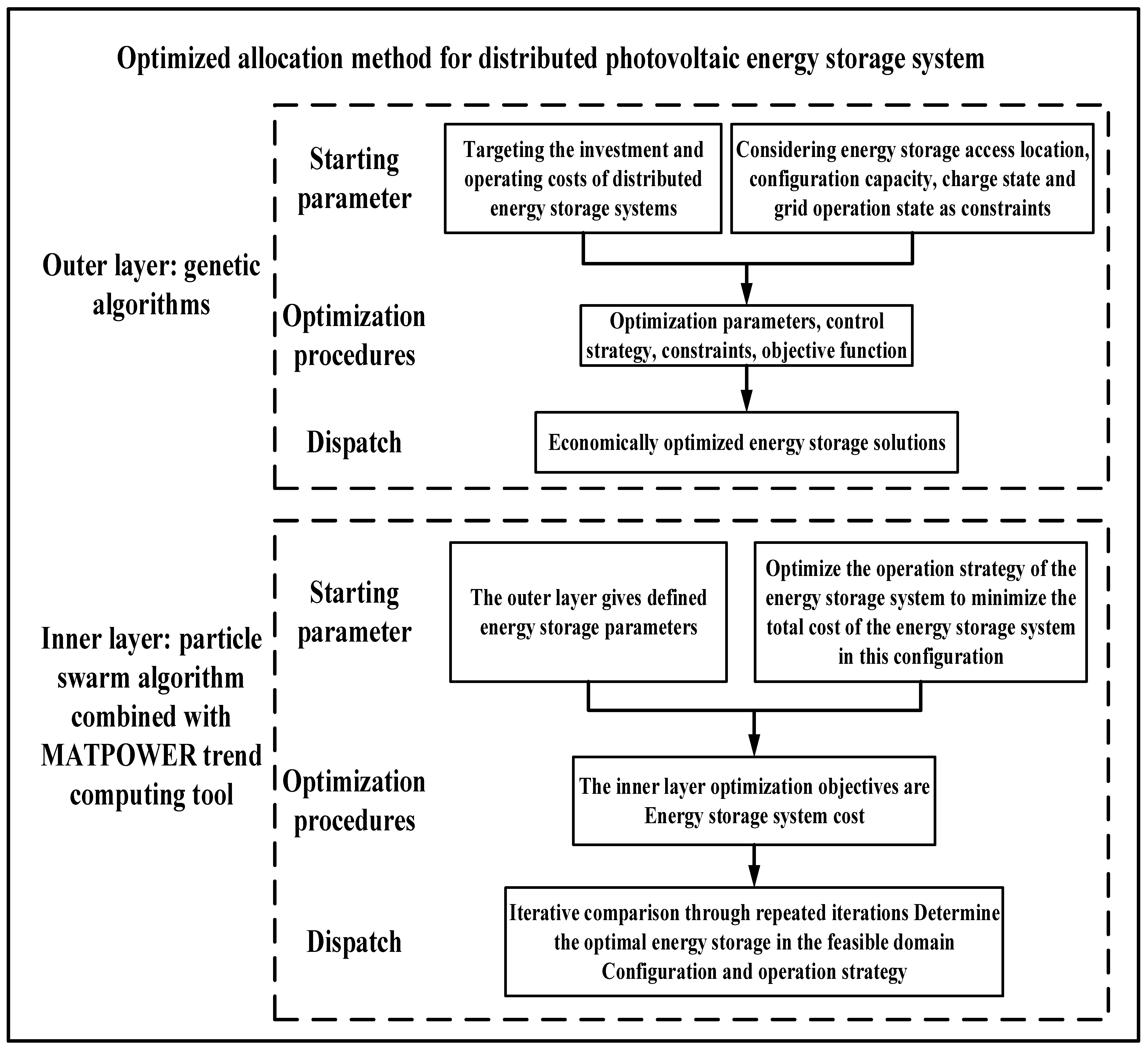

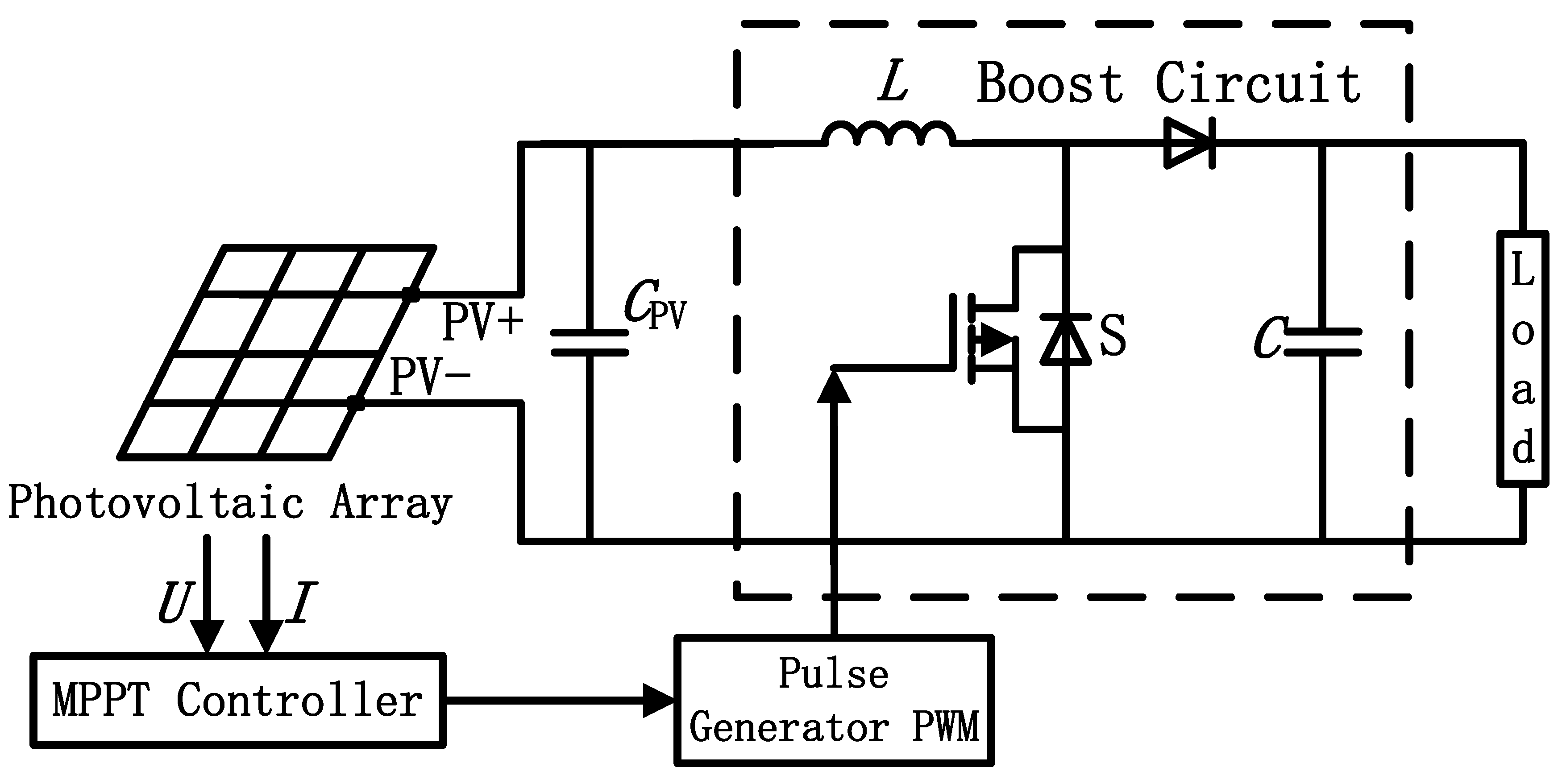

| Algorithm Name | Sophistication | Accurate | Algorithm Advantages | Algorithm Disadvantages |
|---|---|---|---|---|
| Improvement of GA-SA optimization algorithm [24] | High | Moderate | Adaptable, parallel capability, simple algorithm. | High complexity. |
| Particle swarm optimization algorithm [25,26] | Low | High | Algorithm is general, has few parameters, a simple principle, and a fast convergence speed. | Easy to fall into local extreme points. |
| Optimization algorithm for magnetotropic bacteria [27] | High | Moderate | Easy to implement, with few parameters, and applicable to multidimensional non-linear problems. | Complex model with uncertainties. |
| Improved genetic algorithms [28] | Medium | Higher | Introduces non-dominated sorting, high computational efficiency, and high diversity of populations. | Computationally time-consuming, loss of satisfactory solutions, need to specify the shared radius. |
| Pollen pollination optimization algorithm [29] | Low | Moderate | Strong exploitation, fast search, and continuous optimization. | Prone to local optimization and shared radius needs to be specified. |
| Butterfly optimization algorithm [30] | Low | High | Easy to implement, good convergence, and applicable to various types of optimization problems. | Convergence stagnation phenomenon and low processing efficiency. |
| Firefly optimization algorithm [31] | Medium | Higher | Can optimize single-peak and multi-peak functions, strong local search capability, simple implementation, and few parameters. | Strong dependency and easy to oscillate. |
| Optimization algorithm for manta ray foraging [32] | High | High | Strong search capability, good solution accuracy, and robustness. | Insufficient post-search capability and insufficient interval localization accuracy. |
| Ant colony optimization algorithm [33] | Moderate | Moderate | Easy to implement, can handle complex problems, non-linear problems, and large-scale problems, and can adaptively adjust parameters. | Slow convergence, premature convergence, and “stagnation”. |
| Energy Storage Method | Advantages | Drawbacks |
|---|---|---|
| Lithium-ion battery energy storage systems [54] | High energy density, large energy stored per unit volume, long cycle life, can be charged and discharged many times, small self-discharge rate, no self-discharge phenomenon, no memory effect, can be charged at any time, green and environmentally friendly, does not contain lead, mercury, and other harmful substances. | The production cost is slightly higher; although the energy density of lithium-ion batteries is high, its performance will be reduced in high-temperature environments. The cycle life of lithium-ion batteries is relatively short. |
| Compressed air energy storage systems [55] | Fast start-up time (<15 min), high energy and power density, black start capability, large energy storage capacity, low cost, long life, safety, and environmental protection. | Energy storage density is relatively low; energy storage efficiency is low, generally around 70%; energy storage equipment is large and needs to occupy more space. |
| Supercapacitor energy storage system [56] | Fast charging speed, long discharge time, small size and lightweight, easy to install and transport, long life, can be used hundreds of thousands of times, high power density, can provide high power output. | Energy storage density is relatively low; energy storage efficiency is low, generally around 70%; energy storage equipment is large and needs to occupy more space. |
| Liquid-flow battery energy storage system [57] | Ultra-long cycle life, high safety and stability, green, can be deeply discharged. | Batteries are too large, ambient temperature requirements are too high, and more expensive and complex systems. |
| Hydrogen storage systems [58] | Hydrogen storage is clean, efficient, and flexible in production; high density and large storage scale; small cost, which can effectively improve energy utilization. | Low energy conversion efficiency, high investment costs, and higher energy losses than other commonly used energy storage technologies. |
| Pumped storage systems [59,60] | Mature and reliable technology, large energy storage capacity, strong regulation capability, strong economy, long life cycle. | High construction costs, geographic constraints, ecological impacts, and dependence on water resources. |
| Control Methods | Complexity Theory | Accurate | Advantages | Drawbacks |
|---|---|---|---|---|
| Constant pressure tracking method [96] | Lower (one’s head) | Lower (one’s head) | Simple to implement and low complexity. | Inability to adapt to environmental changes and low tracking efficiency. |
| Conductivity increment method [97,98] | Conveniently situated | Conveniently situated | Simple structure and easy to implement. | High hardware requirements and difficult step-size selection. |
| Perturbation observation method [99] | Relatively low | Lower (one’s head) | High tracking accuracy, easy to realize, and simple control structure. | Maximum point fluctuation is large, and misjudgment occurs. |
| Intelligent algorithm [100,101,102] | Your (honorific) | Your (honorific) | Good accuracy and good adaptability to disturbances. | Theoretically feasible but not proven in practice. |
| Deep learning algorithm [103] | Your (honorific) | Your (honorific) | Less computationally intensive, more accurate, and faster learning from experience. | Training samples are heterogeneous and need further optimization. |
| Fuzzy control [104] | Conveniently situated | High | Fast point-finding and anti-interference capability. | More computationally intensive and difficult to implement. |
| Complex algorithm [105] | Your (honorific) | Your (honorific) | High precision, fast response, and strong anti-interference ability. | High algorithmic complexity and more complex model building. |
| Control Methods | Economics | Robustness | Advantages | Drawbacks |
|---|---|---|---|---|
| In-situ [125,126] | Excellent | Higher | Fast response time, improved system stability, optimized energy use, reduced transmission losses, and enhanced grid resilience. | High-cost investment, high technical complexity, reliance on accurate measurement and control, potential compatibility issues, and high maintenance requirements. |
| Centralized [127] | Poor | Lower | Flexibility and stability in site selection and flexibility in operation. | Dependence on long-distance transmission and technical challenges. |
| Distributed [128] | Average | Very high | Improved energy efficiency, reduced losses, and enhanced system reliability and flexibility. | Voltage control complexity; potential impact on grid stability. |
Disclaimer/Publisher’s Note: The statements, opinions and data contained in all publications are solely those of the individual author(s) and contributor(s) and not of MDPI and/or the editor(s). MDPI and/or the editor(s) disclaim responsibility for any injury to people or property resulting from any ideas, methods, instructions or products referred to in the content. |
© 2024 by the authors. Licensee MDPI, Basel, Switzerland. This article is an open access article distributed under the terms and conditions of the Creative Commons Attribution (CC BY) license (https://creativecommons.org/licenses/by/4.0/).
Share and Cite
Zhou, S.; Ge, L.; Zheng, Z.; Wang, M.; Xu, Z. A Review of Distribution Grid Consumption Strategies Containing Distributed Photovoltaics. Appl. Sci. 2024, 14, 5617. https://doi.org/10.3390/app14135617
Zhou S, Ge L, Zheng Z, Wang M, Xu Z. A Review of Distribution Grid Consumption Strategies Containing Distributed Photovoltaics. Applied Sciences. 2024; 14(13):5617. https://doi.org/10.3390/app14135617
Chicago/Turabian StyleZhou, Shouhang, Lijuan Ge, Zilong Zheng, Mingyang Wang, and Zhiwei Xu. 2024. "A Review of Distribution Grid Consumption Strategies Containing Distributed Photovoltaics" Applied Sciences 14, no. 13: 5617. https://doi.org/10.3390/app14135617
APA StyleZhou, S., Ge, L., Zheng, Z., Wang, M., & Xu, Z. (2024). A Review of Distribution Grid Consumption Strategies Containing Distributed Photovoltaics. Applied Sciences, 14(13), 5617. https://doi.org/10.3390/app14135617





